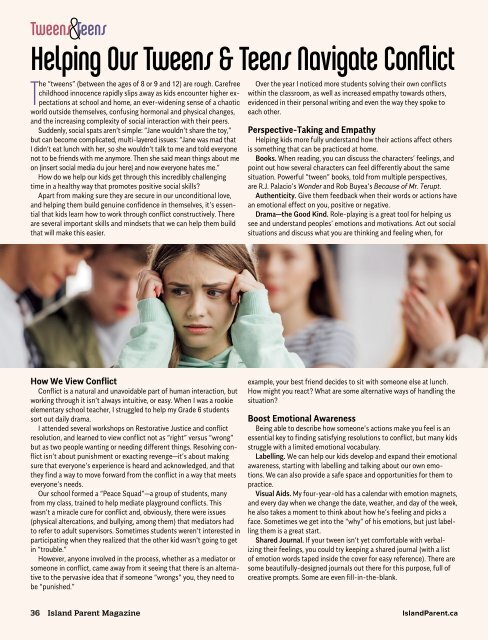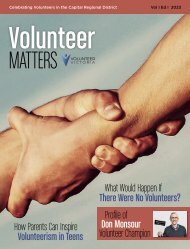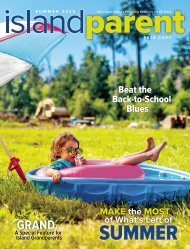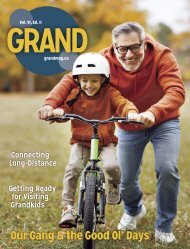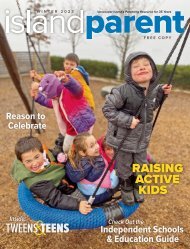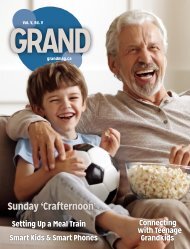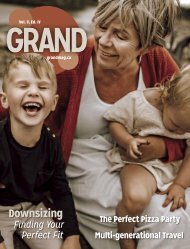Island Parent Fall 2023
Vancouver Island’s Parenting Resource for 35 Years: Out & About in Nature: Rain or Shine • The Cool of Volunteering at School • Lessons from a Little Kid • Setting Kids Up for Success at School • Be Gentle with Yourself • Tweens & Teens
Vancouver Island’s Parenting Resource for 35 Years: Out & About in Nature: Rain or Shine • The Cool of Volunteering at School • Lessons from a Little Kid • Setting Kids Up for Success at School • Be Gentle with Yourself • Tweens & Teens
You also want an ePaper? Increase the reach of your titles
YUMPU automatically turns print PDFs into web optimized ePapers that Google loves.
Helping Our Tweens & Teens Navigate Conflict<br />
The “tweens” (between the ages of 8 or 9 and 12) are rough. Carefree<br />
childhood innocence rapidly slips away as kids encounter higher expectations<br />
at school and home, an ever-widening sense of a chaotic<br />
world outside themselves, confusing hormonal and physical changes,<br />
and the increasing complexity of social interaction with their peers.<br />
Suddenly, social spats aren’t simple: “Jane wouldn’t share the toy,”<br />
but can become complicated, multi-layered issues: “Jane was mad that<br />
I didn’t eat lunch with her, so she wouldn’t talk to me and told everyone<br />
not to be friends with me anymore. Then she said mean things about me<br />
on {insert social media du jour here} and now everyone hates me.”<br />
How do we help our kids get through this incredibly challenging<br />
time in a healthy way that promotes positive social skills?<br />
Apart from making sure they are secure in our unconditional love,<br />
and helping them build genuine confidence in themselves, it’s essential<br />
that kids learn how to work through conflict constructively. There<br />
are several important skills and mindsets that we can help them build<br />
that will make this easier.<br />
Over the year I noticed more students solving their own conflicts<br />
within the classroom, as well as increased empathy towards others,<br />
evidenced in their personal writing and even the way they spoke to<br />
each other.<br />
Perspective-Taking and Empathy<br />
Helping kids more fully understand how their actions affect others<br />
is something that can be practiced at home.<br />
Books. When reading, you can discuss the characters’ feelings, and<br />
point out how several characters can feel differently about the same<br />
situation. Powerful “tween” books, told from multiple perspectives,<br />
are R.J. Palacio’s Wonder and Rob Buyea’s Because of Mr. Terupt.<br />
Authenticity. Give them feedback when their words or actions have<br />
an emotional effect on you, positive or negative.<br />
Drama—the Good Kind. Role-playing is a great tool for helping us<br />
see and understand peoples’ emotions and motivations. Act out social<br />
situations and discuss what you are thinking and feeling when, for<br />
How We View Conflict<br />
Conflict is a natural and unavoidable part of human interaction, but<br />
working through it isn’t always intuitive, or easy. When I was a rookie<br />
elementary school teacher, I struggled to help my Grade 6 students<br />
sort out daily drama.<br />
I attended several workshops on Restorative Justice and conflict<br />
resolution, and learned to view conflict not as “right” versus “wrong”<br />
but as two people wanting or needing different things. Resolving conflict<br />
isn’t about punishment or exacting revenge—it’s about making<br />
sure that everyone’s experience is heard and acknowledged, and that<br />
they find a way to move forward from the conflict in a way that meets<br />
everyone’s needs.<br />
Our school formed a “Peace Squad”—a group of students, many<br />
from my class, trained to help mediate playground conflicts. This<br />
wasn’t a miracle cure for conflict and, obviously, there were issues<br />
(physical altercations, and bullying, among them) that mediators had<br />
to refer to adult supervisors. Sometimes students weren’t interested in<br />
participating when they realized that the other kid wasn’t going to get<br />
in “trouble.”<br />
However, anyone involved in the process, whether as a mediator or<br />
someone in conflict, came away from it seeing that there is an alternative<br />
to the pervasive idea that if someone “wrongs” you, they need to<br />
be “punished.”<br />
example, your best friend decides to sit with someone else at lunch.<br />
How might you react? What are some alternative ways of handling the<br />
situation?<br />
Boost Emotional Awareness<br />
Being able to describe how someone’s actions make you feel is an<br />
essential key to finding satisfying resolutions to conflict, but many kids<br />
struggle with a limited emotional vocabulary.<br />
Labelling. We can help our kids develop and expand their emotional<br />
awareness, starting with labelling and talking about our own emotions.<br />
We can also provide a safe space and opportunities for them to<br />
practice.<br />
Visual Aids. My four-year-old has a calendar with emotion magnets,<br />
and every day when we change the date, weather, and day of the week,<br />
he also takes a moment to think about how he’s feeling and picks a<br />
face. Sometimes we get into the “why” of his emotions, but just labelling<br />
them is a great start.<br />
Shared Journal. If your tween isn’t yet comfortable with verbalizing<br />
their feelings, you could try keeping a shared journal (with a list<br />
of emotion words taped inside the cover for easy reference). There are<br />
some beautifully-designed journals out there for this purpose, full of<br />
creative prompts. Some are even fill-in-the-blank.<br />
36 <strong>Island</strong> <strong>Parent</strong> Magazine <strong>Island</strong><strong>Parent</strong>.ca


